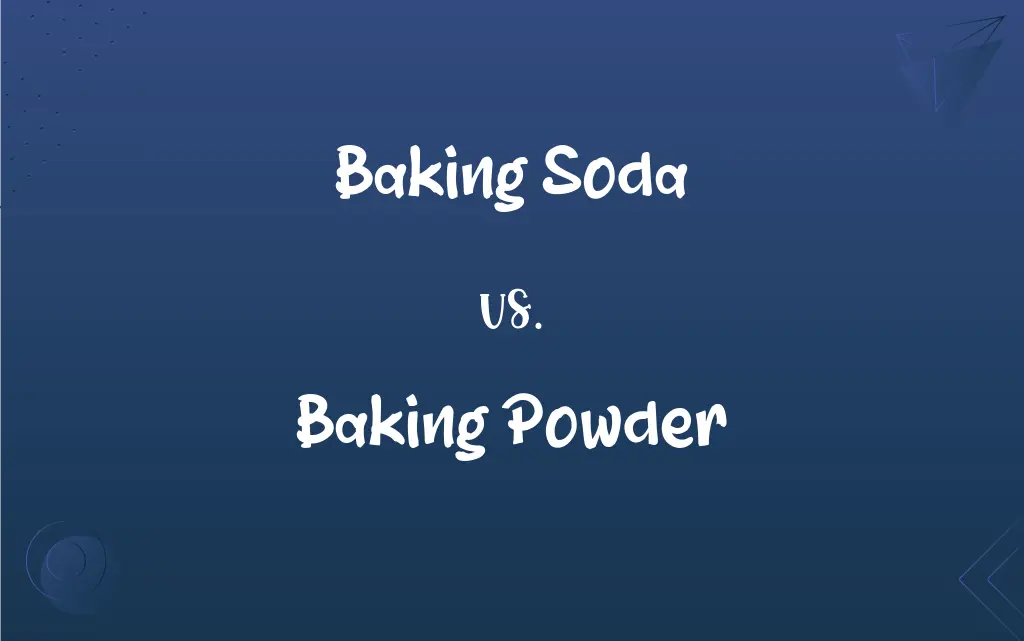Baking Soda vs. Baking Powder: What's the Difference?
Edited by Janet White || By Harlon Moss || Updated on October 12, 2023
Baking soda is a basic leavening agent that needs an acid to activate, while baking powder contains both an acid and a base and activates with moisture.

Key Differences
Baking soda, scientifically known as sodium bicarbonate, and baking powder serve as leavening agents in baking, yet their chemical compositions and applications diverge significantly. Baking soda is a pure chemical compound that is alkaline in nature, necessitating the presence of an acid (like vinegar or lemon juice) within a recipe to initiate the leavening process. Baking powder, contrastingly, contains both an acid (usually cream of tartar) and a base (usually baking soda), forming a complete leavening agent that only requires moisture to activate, making it a versatile and oft-utilized ingredient in various baked goods.
Delving into the nuances of baking soda, it becomes evident that its efficacy is deeply intertwined with the balancing act of acidity and alkalinity within culinary creations. Baking soda mandates an acidic ingredient to facilitate the gas-producing reaction needed to leaven dough or batter. On the other hand, baking powder already embodies both the necessary acidic and basic components, ensuring that it can independently instigate the leavening reaction once it encounters moisture, providing a more fail-safe option for recipes that don’t inherently contain acidic elements.
The potent, single-ingredient nature of baking soda can impart a distinct taste if not adequately neutralized by an acid, making precise measurement pivotal. On the contrary, baking powder, with its in-built acid-base equilibrium, rarely imposes a residual taste on the finished product, offering a more forgiving leeway in terms of measurement and application in baking. Hence, while baking soda demands a meticulous balance with acidity to prevent altering the final flavor profile, baking powder provides a neutral, unobtrusive leavening solution.
Analyzing applications, baking soda often finds a place in recipes already containing a natural acid, like buttermilk pancakes or lemon cakes, ensuring its activation without additional ingredients. Baking powder, with its self-sufficient leavening capability, is employed in recipes where no inherent acid is present, like biscuits or vanilla cakes, providing reliable rise without necessitating additional acidic components. Consequently, baking soda is selected for its precise activating requirements, whereas baking powder is chosen for its inherent leavening reliability.
Considering substitution, baking soda can potentially replace baking powder if an acid is introduced, yet the reverse is not always true due to baking soda’s specific activation needs. Baking powder, in its holistic leavening capacity, can seldom replace baking soda without altering the recipe to accommodate the absence of the latter's basicity. Thus, while baking soda can sometimes step into the role of baking powder with adjustments, substituting baking powder for baking soda typically demands more intricate alterations to maintain the intended outcome.
ADVERTISEMENT
Comparison Chart
Composition
Pure sodium bicarbonate.
Contains sodium bicarbonate and an acid, often cream of tartar.
Activation
Requires an external acid to activate.
Activates with moisture due to containing both acid and base.
Flavor Impact
Can leave a residual taste if not balanced with acid.
Rarely impacts flavor due to its neutral pH balance.
Common Usage
Used in recipes with inherent acidic components.
Used in recipes lacking natural acids.
Substitution
Can replace baking powder with added acid.
Can’t always directly replace baking soda without recipe adjustment.
ADVERTISEMENT
Baking Soda and Baking Powder Definitions
Baking Soda
Baking soda is also known as sodium bicarbonate.
Sodium bicarbonate, or baking soda, is often used in cookie recipes.
Baking Powder
Baking powder is a complete leavening agent used in baking.
Add baking powder to the flour to ensure your cake rises properly.
Baking Soda
Baking soda needs an acidic ingredient to activate.
To make fluffy pancakes, baking soda is often paired with buttermilk.
Baking Powder
Baking powder contains both an acid and a base, typically cream of tartar and baking soda.
Baking powder releases carbon dioxide when moistened, causing dough to rise.
Baking Soda
Baking soda is a pure, alkaline, leavening agent.
When baking soda is mixed with vinegar, it bubbles up, indicating an active leavening reaction.
Baking Powder
Baking powder can be single-acting or double-acting, referring to its release of gases.
Double-acting baking powder releases gas during mixing and baking, ensuring a good rise.
Baking Soda
Baking soda can neutralize acidic flavors in a dish.
A pinch of baking soda in tomato sauce can reduce its acidity.
Baking Powder
Baking powder is typically used in recipes without an inherent acidic component.
Vanilla cake often uses baking powder to achieve a light and airy texture.
Baking Soda
Baking soda has applications beyond cooking, such as cleaning and deodorizing.
You can use baking soda to scrub away stains from your kitchen counter.
Baking Powder
Baking powder has a shelf-life and can lose its potency over time.
Ensure your baking powder is fresh to achieve the desired lift in your baked goods.
FAQs
What activates baking soda?
An acidic ingredient like vinegar or lemon juice activates baking soda.
What is baking powder?
Baking powder is a leavening agent containing both an acid and a base, activating with moisture.
Is baking powder the same as baking soda?
No, they differ in composition and activation requirements in recipes.
How is double-acting baking powder unique?
It releases gases in two stages: when moistened and when heated.
What is baking soda?
Baking soda is sodium bicarbonate, a basic leavening agent requiring an acid to activate.
How does temperature affect baking soda reactions?
Higher temperatures expedite the release of gases from baking soda.
Why might a recipe need both baking soda and baking powder?
To balance acidity while providing sufficient leavening without affecting flavor.
What happens if I use too much baking soda?
Excess baking soda can impart a soapy taste and overly browned color.
How does baking soda affect cookie texture?
Baking soda can create a coarser texture and browner color in cookies.
Can I use baking powder in cleaning like baking soda?
Baking powder is less effective for cleaning due to its added ingredients.
Can I omit baking powder from a recipe?
Omitting can impact rise and texture, and is generally not recommended without substitution.
How do I test if baking powder is still good?
Mix with water; effective baking powder will fizz immediately.
Why is baking powder used in cake recipes?
To provide leavening, ensuring a light and fluffy cake texture.
Can expired baking powder be harmful?
It’s not harmful but can compromise the rise in baked goods.
How much baking powder should I use in recipes?
A common ratio is 1 teaspoon of baking powder per 1 cup of flour.
Can I substitute baking soda for baking powder?
Substituting requires adding an acid and adjusting quantities due to differing potencies.
Can I make homemade baking powder?
Yes, by mixing baking soda with cream of tartar and sometimes, cornstarch.
Does baking powder affect flavor?
Baking powder is generally neutral in flavor if used in appropriate amounts.
Why does baking soda need an acid to activate?
Its basicity requires an acid to produce the carbon dioxide necessary for leavening.
How do I store baking powder and baking soda?
Store in a cool, dry place and check for efficacy before use.
About Author
Written by
Harlon MossHarlon is a seasoned quality moderator and accomplished content writer for Difference Wiki. An alumnus of the prestigious University of California, he earned his degree in Computer Science. Leveraging his academic background, Harlon brings a meticulous and informed perspective to his work, ensuring content accuracy and excellence.
Edited by
Janet WhiteJanet White has been an esteemed writer and blogger for Difference Wiki. Holding a Master's degree in Science and Medical Journalism from the prestigious Boston University, she has consistently demonstrated her expertise and passion for her field. When she's not immersed in her work, Janet relishes her time exercising, delving into a good book, and cherishing moments with friends and family.































































